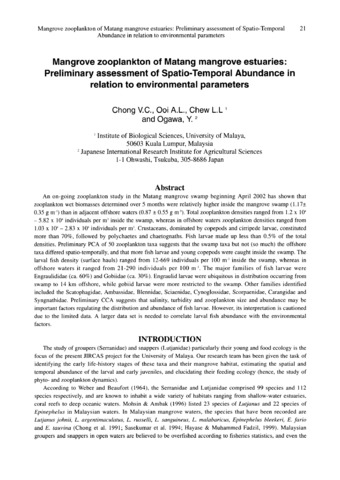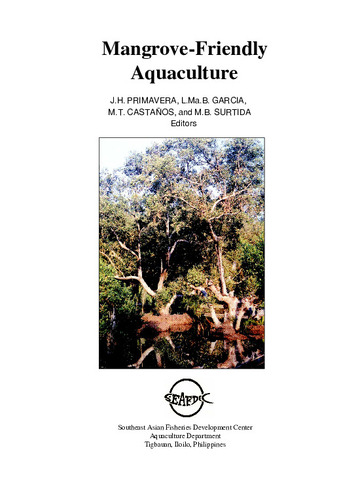Mangrove zooplankton of Matang mangrove estuaries: Preliminary assessment of spatio-temporal abundance in relation to environmental parameters
- Global styles
- MLA
- Vancouver
- Elsevier - Harvard
- APA
- Help
Share
Abstract
An on-going zooplankton study in the Matang mangrove swamp beginning April 2002 has shown that zooplankton wet biomasses determined over 5 months were relatively higher inside the mangrove swamp (1.17± 0.35 g m-3) than in adjacent offshore waters (0.87 ± 0.55 g m-3). Total zooplankton densities ranged from 1.2 x 104 - 5.82 x 104 individuals per m3 inside the swamp, whereas in offshore waters zooplankton densities ranged from 1.03 x 104 - 2.83 x 104 individuals per m3. Crustaceans, dominated by copepods and cirripede larvae, constituted more than 70%, followed by polychaetes and chaetognaths. Fish larvae made up less than 0.5% of the total densities. Preliminary PCA of 50 zooplankton taxa suggests that the swamp taxa but not (so much) the offshore taxa differed spatio-temporally, and that more fish larvae and young copepods were caught inside the swamp. The larval fish density (surface hauls) ranged from 12-669 individuals per 100 m-3 inside the swamp, whereas in offshore waters it ranged from 21-290 individuals per 100 m-3. The major families of fish larvae were Engraulididae (ca. 60%) and Gobiidae (ca. 30%). Engraulid larvae were ubiquitous in distribution occurring from swamp to 14 km offshore, while gobiid larvae were more restricted to the swamp. Other families identified included the Scatophagidae, Ambassidae, Blennidae, Sciaenidae, Cynoglossidae, Scorpaenidae, Carangidae and Syngnathidae. Preliminary CCA suggests that salinity, turbidity and zooplankton size and abundance may be important factors regulating the distribution and abundance of fish larvae. However, its interpretation is cautioned due to the limited data. A larger data set is needed to correlate larval fish abundance with the environmental factors.
Suggested Citation
Chong, V. C., Ooi, A. L., Chew, L. L., & Ogawa, Y. (2003). Mangrove zooplankton of Matang mangrove estuaries: Preliminary assessment of spatio-temporal abundance in relation to environmental parameters. In Y. Ogawa, H. Y. Ogata, Y. Maeno, T. Shimoda, Y. Fujioka, & Y. Fukuda (Eds.), Proceedings of the 2nd Workshop of the JIRCAS International Collaborative Research: Studies on Sustainable Production Systems of Aquatic Animals in Brackish Mangrove Areas , December 2-3, 2002, Penang, Malaysia (pp. 21-43). Japan International Research Center for Agricultural Sciences.
Type
Conference paperISSN
1341-710XSeries
JIRCAS Working Report;No. 35
Related items
Showing items related by title, author, creator and subject.
-
Mangroves as nurseries: Shrimp populations in mangrove and non-mangrove habitats
Primavera, J. H. (Elsevier, 1998)A total of 4845 penaeids belonging to nine species—Metapenaeus anchistus, M. ensis, M. moyebi, M. philippinensis, Penaeus merguiensis, P. monodon, P. semisulcatus, P. latisulcatus and Metapenaeopsis palmensis—were collected ... -
Mangrove-Friendly Aquaculture : Proceedings of the Workshop on Mangrove-Friendly Aquaculture organized by the SEAFDEC Aquaculture Department, January 11-15, 1999, Iloilo City, Philippines
Primavera, Jurgenne H.; Garcia, Luis Ma. B.; Castaños, Milagros T.; Surtida, Marilyn B. (Aquaculture Department, Southeast Asian Fisheries Development Center, 2000)The proceedings have three review papers on the mangroves of Southeast Asia, silvofisheries, and Indonesia's integrated mangrove forest and aquaculture systems. The rest of the papers, all on mangrove-friendly aquaculture ... -
Retaining our mangrove greenbelt: Integrating mangroves and aquaculture
Although multilateral agencies in Southeast Asia have long been promoting that mangroves, and other wetlands, are wastelands to be put into better use, such as conversion to ponds. However, there is a need for Mangrove ...






